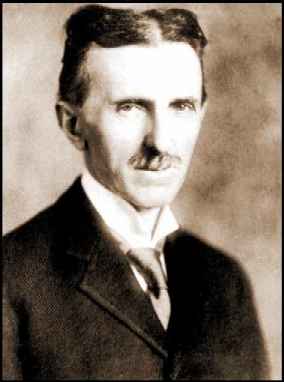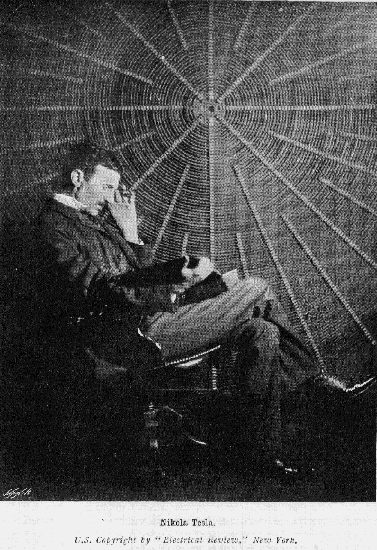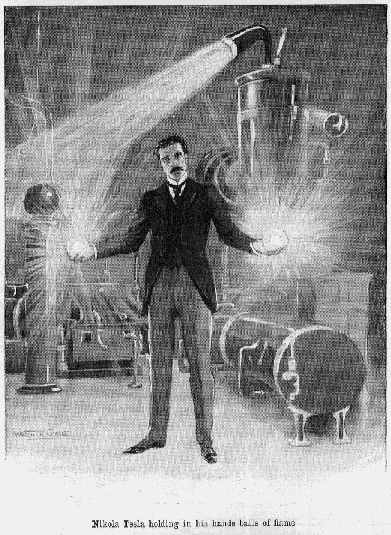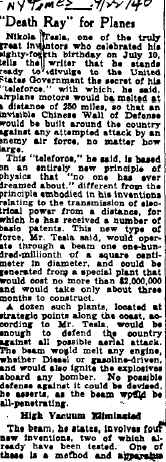|
Nikola Tesla Don't ever say Serbo-Croatia never did anything for you. If it wasn't for Nikola Tesla, you might not be reading this now. Your cell phone would be little more than a paperweight, and the government wouldn't have lethal orbiting death ray satellites with which to ensure your safety.
Don't ever say Serbo-Croatia never did anything for you. If it wasn't for Nikola Tesla, you might not be reading this now. Your cell phone would be little more than a paperweight, and the government wouldn't have lethal orbiting death ray satellites with which to ensure your safety.The young Serbian discovered the principle that drives almost every practical use of electricity today, the rotating magnetic field. The field is what powers generators and all forms of electrical motors. Although the generator had already been discovered, it was Tesla who figured out why it worked. Tesla's understanding of the rotating magnetic field led him to develop groundbreaking ideas about how to use alternating current, and one of his first inventions was the induction motor, a powerful device powered by AC. Tesla had big dreams of the mad scientist variety, including flying machines and other more sinister deals. As everyone knows, there's only so far a mad scientist can go in Croatia, so in 1884, it was off to America! Tesla worked for Thomas Edison briefly, but mad scientists aren't widely known as team players, and the relationship was a bust. He was bought out by Westinghouse in 1885, when the titan of industry bought his patents for AC-driven motors. The first thing Westinghouse did with the technology was put Edison's DC-powered gadgets out of business. That's gratitude for you. Tesla set up shop on his own and began inventing things, such as specialized lighting and a precursor to the X-ray machine. He liked to wow the marks by running electrical current through his body to light lamps. He was that kind of guy. This sort of behavior made him popular at high school assemblies and Masonic lodges. In 1891, Tesla became a U.S. citizen, which as we all know is a free ticket to megalomania. He started to dream bigger. Within a few years, he was building massive hydroelectric generators powered by Niagara Falls. He invented the first remote control, and began researching wireless communications. Around the turn of the century, Telsa made he considered his most important discovery even though no one has ever heard about it, it isn't discussed in classrooms, and it doesn't appear to have any practical applications except for James Bond villains.
Tesla saw great possibilities for his TS waves, including creating a worldwide integrated system of centralized control and distribution electronics, stock tickers and all manner of not-yet-invented communications technology, with provisions for secretly encrypted point-to-point transmissions. It was around this time that the government began to really take an interest in Nikola Tesla. In his quest to test the limits of the terrestrial waves, Tesla began a period of extensive experimentation. during which he developed the Tesla Coil, a method for delivering high-voltage current which is still used in many TVs and other applications today. Using the coil, Tesla asked himself: If the Earth can conduct electricity, and the electricity vibrates around the world in waves through the planet, just how much electricity can the Earth hold? A reasonable question! He could think of no better way to answer that question than by dumping as much electricity as he could generate into the ground, just to see what would happen. Many a bad science fiction movie has opened with this sort of premise. Fortunately, the outcome of Tesla's tests were more of an inconvenience than a cataclysmic world-ending event. Well, depending on your perspective anyway. The area around his experiement became electrified, but not enough to kill anyone, and there were some very impressive bolts of man-made lightning which stopped when he blew up the town's generator and caused a blackout over several miles. There might have been one other small side effect. At almost exactly the same time that this experiment was taking place, a mysterious explosion rocked a remote section of Siberia, to the tune of about a 15-megaton blast (40 years before the first Atomic Bomb test). The explosion has never been satisfactorily explained, although it is commonly dismissed as a meteor or comet impact (a claim which doesn't quite add up with the measured damage on the scene). Interestingly, Tesla had claimed he was trying to use to wave to send a communication to an Arctic expedition that can supposedly be located along a straight line path between Tesla's lab and the site of the explosion.
As lousy in business as he was talented in science, Tesla sank into bankruptcy and many of his projects went down with him. For years, he struggled to get by and bring his ideas to fruition, but his ideas had taken a turn toward the decidedly strange. He became obsessed with interplanetary communication, for which he was derided (even though, years later, his work is now integral to space exploration and the search for intelligent life in the universe). He also began to make some interesting claims about his abilities and the power of his inventions. He told people he possessed the scientific wherewithal to split the Earth in two, and he told the New York Times he had invented a death ray which he called the "teleforce," which could melt an airplane's engine from a range of 250 miles. The Times, noting the massive spending on defense and military issues in the build-up toward World War II, pointed out that on a cost-benefit basis (and based on Tesla's track record), it was well worth the risk of failure to fund the project. Nevertheless, the "teleforce" was never adopted... publicly. The "teleforce" claim would haunt the United States for decades to come. According to Tesla, he had designed a system through which a series of beam transmitters could create an impenetrable energy shield around the country. Starting to sound familiar? It was the first "Star Wars" proposal, and Tesla's claims (never verified publicly) formed the blueprint for almost all future discussions of the "Strategic Defense Initiative."
The end result was military technology nearly identical to Tesla's inventions, but developed literally decades later and at many times the cost. Tesla never made a dime off of the discovery of the radio-controlled automation that today is the basis of a multibillion dollar aerospace specialty, responsible for the CIA drone assassin planes used in the War on Terrorism, and in every generation of the Mars lander probes. After his death in 1943, the FBI raided Tesla's home and seized all of his scientific notes, to the tune of hundreds of pages. While a pretty fascist act, it's kind of understandable in light of his claims. Tesla's heirs eventually won the release of some of the material, but it's unknown how much is still classified or "lost." Conspiracy theorists are enamored of Tesla for obvious reasons, and there is a lot of speculation about that "death ray" and other aspects of his research. One of the most popular theories is that Tesla's terrestrial stationary waves and "death ray" research form the basis of the HAARP Project, an alleged top-secret U.S. government experiment to control the weather and beam fiery death from the skies against enemies of the state. Tesla's work is still of broad interest to people who are interested in death and destruction on a large scale. Members of Japan's Aum cult (notorious for a sarin gas attack in Tokyo) visited the Tesla Museum looking for ideas, and members of al Qaeda have allegedly taken an interest as well, although it appears fertilizer bombs and box cutters are about as much technology as Osama bin Laden cares about since the incarceration of his own personal mad scientist, Ramzi Yousef. |
 They were called terrestrial stationary waves, and what that basically means is that you can a) transmit electrical current using the Earth as a conductor, and b) you can cause the Earth to vibrate on a frequency, much like a tuning fork. I'm sure you can see where this is going. Try to name five non-mad-scientist uses for such a discovery. Powering streetlights without wires? Yeah, OK, that's pretty cool. Beaming lethal destruction around the globe? Whoops! Manipulating the weather? Controlling earthquakes?
They were called terrestrial stationary waves, and what that basically means is that you can a) transmit electrical current using the Earth as a conductor, and b) you can cause the Earth to vibrate on a frequency, much like a tuning fork. I'm sure you can see where this is going. Try to name five non-mad-scientist uses for such a discovery. Powering streetlights without wires? Yeah, OK, that's pretty cool. Beaming lethal destruction around the globe? Whoops! Manipulating the weather? Controlling earthquakes?  During all this, Tesla was also pushing ahead with his investigation of the uses of radio waves, particularly to remotely control robotic devices, an area in which the Serbian made great breakthroughs. His research into radio either ran parallel to Guglielmo Marconi, or Marconi ripped him off. The outcome was that Tesla was gipped out of the Nobel Prize in favor of Marconi, who won the official title of "inventor of radio" in the history books. Tesla's inventions and discoveries also formed the basis of modern robotics, radar, most forms of wireless communications, loudspeakers and more. Few of these breakthroughs are credited to the inventor, even today.
During all this, Tesla was also pushing ahead with his investigation of the uses of radio waves, particularly to remotely control robotic devices, an area in which the Serbian made great breakthroughs. His research into radio either ran parallel to Guglielmo Marconi, or Marconi ripped him off. The outcome was that Tesla was gipped out of the Nobel Prize in favor of Marconi, who won the official title of "inventor of radio" in the history books. Tesla's inventions and discoveries also formed the basis of modern robotics, radar, most forms of wireless communications, loudspeakers and more. Few of these breakthroughs are credited to the inventor, even today.  Tesla was clearly ahead of his time, a problem which would haunt his entire career. His inventions and patents for remote operation of robotic devices, for instance, were stunningly advanced but largely ignored at the time. The military inexplicably failed to understand the usefulness of remote-controlled attack vehicles and torpedoes until after Tesla's patents had expired. Even then, they began researching it over from scratch, rather than working with his established techniques.
Tesla was clearly ahead of his time, a problem which would haunt his entire career. His inventions and patents for remote operation of robotic devices, for instance, were stunningly advanced but largely ignored at the time. The military inexplicably failed to understand the usefulness of remote-controlled attack vehicles and torpedoes until after Tesla's patents had expired. Even then, they began researching it over from scratch, rather than working with his established techniques.